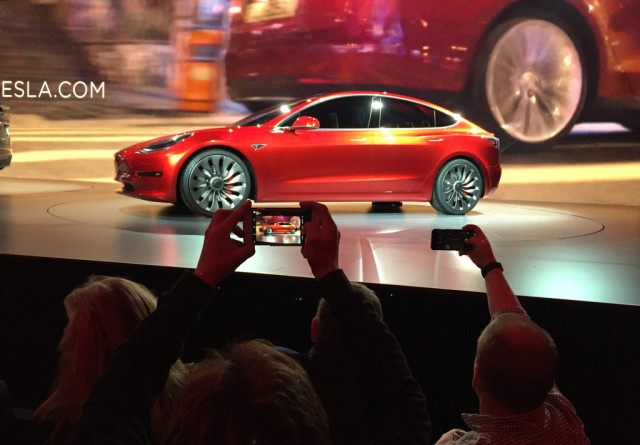The Tesla Model 3 sedan is on track to introduce the world’s top safety features — if the company doesn’t collapse financially before many of the cars reach the market.
Morgan Stanley’s auto analyst Adam Jonas’s latest industry update predicts that with almost every auto manufacturer emphasizing that safety is now the number one determinant for consumers purchasing a car, the Tesla Model 3’s hardware and software will provide a level of “active safety” that could be a ten times better than the average car on the road.
Based on the opportunity for such a commanding consumer product advantage, Jonas raised Tesla’s stock rating to “Overweight” and set a 20 percent higher price target of $305 a share.
Jonas’s recommendation relies on the technical prowess of Tesla’s self-driving Autopilot System, which already collects about 5 million miles of road data per day, which he believes will double over the next 15 months.
Jonas also estimates that with Tesla Mobility ride-sharing soon to be rolled out, the company’s fleet will be 4-times larger than Uber’s current network by 2025.
But that assumes a massive financial turnaround, since Tesla has not made an annual profit in 14 years, never met a production schedule, is suffering massive cash burn, and has already expended $700 million in pre-paid customer deposits.
Breitbart News noted in late February that Tesla’s CFO resigned after the company reported running $448 million in negative cash flow for the latest quarter. In addition, Breitbart News estimated that Tesla would be in violation of its bank loan’s fixed charge coverage ratio test within 90 days and had to raise at least $900 million in short order.
Three weeks later, Tesla sold $1 billion in stock and debt. But with an SEC filing confirming the negative cash burn was accelerating, the New York Times’ Deal Book warned that the “Cash Raise May Fall Short” of the $2.5 billion for capital spending Tesla needs to finance the Model 3’s first 12 months following its July launch.
In his shareholder call following the stock and bond offering, CEO Elon Musk stated that he expects to complete the Model 3’s production tooling in about one to two weeks. Musk then confidently stated that because of “advanced analytical techniques,” the Model 3 was designed for manufacturability, so Tesla could skip the traditional 6-to-12 month beta testing phase. Musk promised that the first Model 3s built in the July/August period would be “Release Candidates” and immediately shipped to customers.
Open public beta testing is a hallmark of Silicon Valley’s disruptive Y Combinator strategy of “Ship Early and Ship Often.” But there is a monstrously bigger risk of injury and death between immediately shipping a PayPal smartphone applications and a 3,600-pound self-driving Tesla Model 3 that can quickly accelerate to over 100-miles per hour.
Breitbart News reported that Tesla was forced to recall all 90,000 Model S cars in late 2015 over the risk of seat belt failures. Consumer Reports revised its quality rating score for the $127,820 Model S to a “worse than average” 43, after receiving 1,400 owner responses complaining about squeaks, rattles, and multiple electric motor replacements. Tesla is currently being sued for alleged deaths and injuries due to Autopilot failures.
Tesla is often called the most innovative car company since the launch of the 1948 Tucker Torpedo. But the company ran out of cash after only producing 51 cars. But the last Tucker Torpedo sold at auction for $2,915,000.

COMMENTS
Please let us know if you're having issues with commenting.